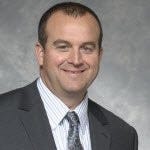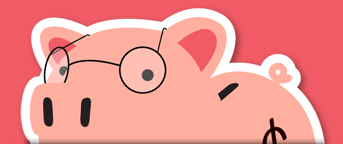The Liberal Arts, studied as designed, help understand the universe and help one become a free person, one able to shift and pivot, learning throughout life, sculpting a life to fit their unique vision and desire.
What would you do if you grew up running your teenage businesses, earned your bachelor’s degree from DePauw University in Psychology and Business and realized advertising and marketing would be a great match for you?
Might you end up launching a fintech, a banking startup, growing it, forking it into two, selling it only to embark on yet another banking initiative, this time within a bank itself?
Would you?
Origins
Those who know Mike Ferrari in the Iowa startup community know him for his quiet leadership. His influence and expertise is recognized and valued by Fintech founders outside Des Moines far more than in his home community. I first met Mike in the late 1990s when my company was hired to create websites for Meyocks and Priebe (M&P) advertising, a premier marketing firm in West Des Moines. Mike’s colleague, Jim Thalacker, had found a bunch of us (an island of misfit toys who remain friends) and brought us together in their fabled Quonset Hut conference room.
Mike had recently completed a 10-year call of duty at Kragie/Newell advertising, serving marquee customers such as McDonalds. He had risen from an assistant Account Executive role to a broad set that included multi-state territories. Upon leaving Kragie/Newell, he joined Group3, a firm to capitalize on his creative expertise but received an offer from Ted Priebe he couldn’t refuse.
The move to M&P was designed to create a new opportunity for leading product development. The internal and external technical teams developed websites for the city of Council Bluffs, Hy-Vee amongst others. As the teams dissipated over time, Mike too, moved on to lead a larger team at the Integer group.
Working in the creative industry comes with an advantage - you are destined to ideate, create, and think. An idea that kept percolating was around helping people save money. Influenced, perhaps, by a growing family and a new home, Mike imagined and search for goal-based savings. It was during a multi-hour wait while on a golf trip to AZ, he found himself daydreaming. If there is a spark to the origin story, it is here as Mike lit up remembering the moment he pulled out his laptop and documenting the idea for his next step.

Targeted Savings Plans
The industry guiding people to save toward specific initiatives or desires isn’t new. I’d experienced “Kitty Parties” in India where women came together monthly to save for a purpose (I think my mom bought our washer and dryer in this manner), seen banks help customers with Christmas and vacation accounts. Mike’s idea had to have existed already - or so he thought.
However, he found the market open for the taking. Googling revealed nothing. The flight home a blur as the business plan continued to take shape. Jazzed at the prospect of building something new, he and his wife knew the time was right to jump all-in.
Mike found an friends and family money, was joined by Jon Gaskell as a co-founder, and an angel investor, true to the spirit, in Sean McMurray.



The seed round, $170,000, helped them start small with a token salary and the commitment of significant sweat equity. They knew that they were capable of designing, developing, and ideating and finding additional development team members. Mike brought his creative spirit and designed the initial user experience as storyboards and ideas to frame the product. They had an additional hurdle to overcome - find a bank who’d work with them.
They named the company and product SmartyPig.
The First Hurdle of Banking - Banking
I once experienced a set of systems that were facetiously equated with a tightly bound ball of twine. Bank systems at Smartypig’s launch were not much different. Some older than the personal computer, these balls of twine were impervious to innovation. The system publishers had enormous hesitation to modify or open them up and risk disruption. Opacity removed obsolescence and guaranteed perpetuity.
SmartyPig was designed with the ability to ‘create’ a bank account, manage the ledger, and transact money inflows and outflows. Despite having found West Bank as the innovation-seeking bank partner by this time, they realized they had no way to work with the bank’s core systems. An Application Programming Interfaces (API), a standard of modern systems was either non-existent or tightly guarded for the banking core software providers’ own use.
It was time to choose between giving up their dream of bank integration and decommission SmartyPig, or building a bank from scratch and obtain a bank charter, or build a completely isolated, fully autonomous, independent duplicate of the basic technology.
They chose to ignore the ball of twine and build a parallel technology
With the bank as an investor and strategic advisor, the SmartyPig team set out to grow and build. Sean, their angel investor and owner of the company Datavision, offered up a part of his development team. Dan Schultz joined the company as CTO and began an effort to build a development team. The team built the software to open/close accounts, receive deposits, process withdrawals, compute interest, pay interest, generate statements, generate 1099 tax forms, and myriad other functions performed by a bank. As they couldn’t “talk” to the bank’s systems, they were virtually air-gapped away from the bank’s core operations.
SmartyPig may have never happened had they not created a shadow of core banking software. Neither might have Dwolla, who launched a few years later with a banking partner and a shadow of the core to disrupt the credit card payments network.
It should surprise the readers of this Substack that two (there’s more… standby 😊) Fintech companies launched in Iowa within a four-year period and created a banking technology stack because at least two bankers (usually indicted as risk averse) shared a vision of disruption and invested personal and political capital.
A misstep
The SmartyPig team realized that they’d inadvertently created a disruptive technology from a blueprint and developed core banking system. So, they did what any wide-eyed entrepreneur would do - they set out to conquer the world and its banks.
The founding team and investors crossed the globe, from Singapore, India, Australia and all over the US. Several banks that saw the team’s vision desired the branding to reflect the bank’s brand rather than SmartyPig’s. Geoff Wood’s 2009 archived interview with Mike speaks to the relationship The Australia and New Zealand Banking Group Ltd. The SmartyPig team built the personalized brand, white labeling the product to meet the bank’s exacting needs.
Companies usually accomplish such white labeling by duplicating their software code and making the custom modifications to the copy. These custom modifications in the Australian market included different currency, tax laws, reporting, authentication methods, customer management, and much more. Throughout, they made enhancements and improvements to the product which would need to be duplicated into the original.
In a sad twist, by the time the personalized codebase was ready for the Australian bank, a new executive team at the bank reprioritized its strategy. The project was shutdown. Significant revenue for white labelling had exacted an opportunity cost.
Reset & Growth
The team had continued to build with their Des Moines-based banking partner and was processing deposits. It began to realize that growing deposits would require a banking partner large enough that the parallel core would not cause a regulatory challenge. SmartyPig leaned into its banking partner, investors, and its own leadership team to find such a partner. They landed upon BBVA Compass.
Banco Bilbao Vizcaya Argentaria (BBVA) is a global bank domiciled in Spain with operations across Europe, South America and the US. In came to the US in 2007 by acquiring Alabama Compass and expanded by acquiring the failed Guaranty bank of Texas. It is lauded for a highly successful digital transformation launched in 2007 that grew the bank’s customers, deposits, and influence. This large banking partner opened up the ability for SmartyPig to take on more deposits as it grew in the early 2010s.
Though the revenue models are not publicly disclosable, there was room for SmartyPig and the bank partners to grow profitably while providing customers with a valuable service. This growth was recognized by other fintech companies and SmartyPig executive and technical leadership started fielding calls from entrepreneurs trying to design banking innovations. Entrepreneurs sought basic guidance such as answers to “How do you create the bank account”, “How do you perform ACH in either direction”, “How do you interact with the bank’s ledger”.
These calls for help can become A-ha moments for the vigilant entrepreneur. Mike and team seized the opportunity.
When product became plumbing
The very technology SmartyPig had sought years before was now their asset and fintech entrepreneurs wanted it. Well-funded entrepreneurs from both coasts were flying into Des Moines for a demo in SmartyPig’s 8th Street office in West Des Moines, abutted by a Jimmy Johns on one end and a Kum & Go across the parking lot. Household names like Betterment, CashApp and MoneyLine all made the pilgrimage.
The demo they received was for the company’s CorePro, a set of APIs the company had developed in parallel. These APIs, with associated documentation and test systems for anyone to interface with any bank were antithesis of opaque cores of the past. Fintech founders recognized the opportunity provided as they would neither need to learn the underlying technology nor have to devote years developing it.
SmartyPig’s sister company, CorePro was now selling picks and shovels to fintechs seeking gold in financial services.
In 2014, Steve Case, previously retired CEO of America Online was touring the United States on a “Rise of the Rest” bus tour. SmartyPig and CorePro were a memorable stop as the tour recognized and highlighted the very type of innovations their own journey was intended to unearth across the middle of the US.
Sadly, the video recap below doesn’t include the stop at SmartyPig.
Innovation Cultures
SmartyPig was strategic and lucky. It found the perfect partner early in West Bank who took risks and grew with them. Luck and strategy combined again as CoreAPI launched when Lincoln Savings Bank, another innovative Iowa bank agreed to be their first customer/partner for CoreAPI. They’d been working with Stockholm-based Qapital looking to launch a fintech product in the US and found a perfect fit in CoreAPI.
By contrast, their prior experience with the large bank in Australia and another large bank on the coast could’ve soured them completely on large companies but an open mind allowed them to look far and wide. The BBVA relationship, one of the world’s largest banks, was an obvious result.
A Harvard study is cited by corporations resisting core innovation as it highlighted that 80% of corporate innovation efforts fail. What the citers fail to acknowledge is that alpha is still achieved by the 20%.
On being Found
Shortly after the Rise of the Rest bus had rolled out of Des Moines, and Lincoln Savings Bank, BBVA Compass, Qapital and other banking relationships were growing, Q2 came calling. Q2 Holdings, the parent company of the software company Q2 was building a software stack for the future of fintech. As an Austin, TX based company with a $1.1B market capitalization, it had the resources necessary to inorganically expand and acquire the most promising technologies. It had acquired a Lincoln, NE fintech in 2014 and by the end of 2015 completed the acquisition of SmartyPig and CoreAPI.
The 12-person team in West Des Moines continued to operate from their offices.
As is customary in such acquisitions, Mike stayed on with Q2 and continued to do what he’d loved throughout his time with the companies he’d built - business development and talking to fintechs and banks. His interests naturally allowed other innovative banks to gravitate toward him and the next opportunity arose from West Virginia and Mike became a remote employee for the bank.
He would work with other household names such as Creditkarma, DraftKings and FanDuel, all approaching Fintech with their own unique market propositions. As the non-banking innovator, Mike found a new groove in another innovative bank.
As he continued to work with the MVB team, he connected with a colleague who had served in a role closely reflecting that of a chief operating officer of SmartyPig from years past, Bob Weinschenk. Bob was, by now, working for Austin-based Austin Capital Bank and was interested in furthering the bank’s already strong fintech aspirations, renewing its technology stack and building the team best suited for fintech innovation.
The juxtaposition of banks and Fintechs
Banks, the traditional entities complete with large buildings, vaults, and risk management can be as impervious as the marble and granite that adorn their buildings and lobbies. Fintechs, on the other hand, are symbolized by a small crowd of Patagonia-vest donning entrepreneurs wanting to transform the old school through software and applications that reimagine money storage, movement, and growth.
The irony is that many banks want to be Fintechs, tapping into the energy and desires of Fintechs customers who no longer value the granite buildings or vaults. Fintechs, however, cannot achieve their goals without a bank charter to back their entrepreneurial dreams - a charter that provides them access to a regulated service. Magical intersections happen when the bank has the courage to shed its history for adopting an undefined future.
Austin Capital Bank (ACB) demonstrated such a future and Mike made the jump. The bank had created a largely flat structure and Mike tapped into his old team, led once again by Dan Schultz to strengthen the ACB’s development group.
Fast forward to today
Austin Capital Bank’s Des Moines office sits undiscovered in a space once occupied by a consulting company. The multi-tiered modern workspace is new again and my conversation with Mike at this office had the feels of an emerging startup. And it is already full, now that Mike Ferrari, Dan Schultz, and the development team have repurposed the old offices, cubicles, and a mezzanine floor to support their Austin HQ.
The team is building a proprietary technology stack for the bank, combining a FDIC-insured bank’s charter with world-class technology and best-of-breed third-party solutions to solve unmet critical financial needs.
They’re so busy building that they haven’t even had the time to adopt the industrial kitchen or coffee paraphernalia left behind.
I am a proud member of the Iowa Writers Collaborative and the Iowa Startup Collective. Each writer is independent and publishes via Substack across Iowa.










What an interesting and winding journey! Thank you for telling this story. I love the lesson of innovation.
Fascinating story, well crafted and researched, with a compelling protagonist at the center. Thanks!